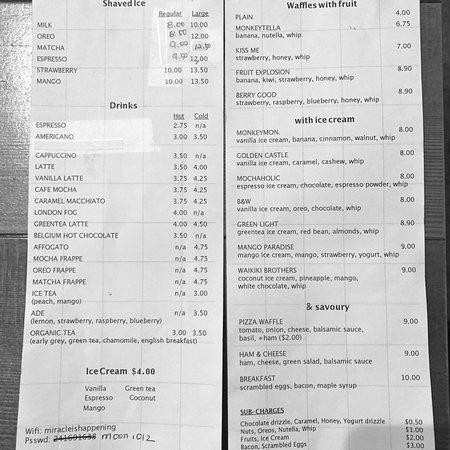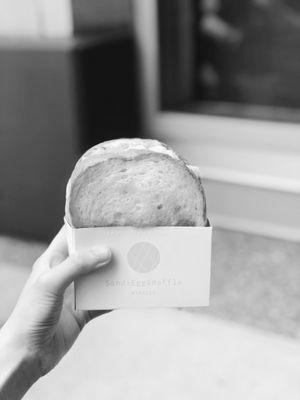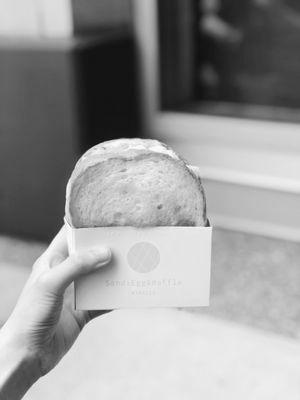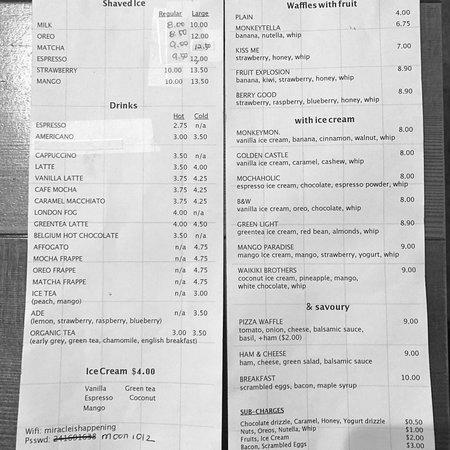Intro
“What’s your miracle waffle?”
“Your miracle waffle is delicious.”
How many times have you heard that sort of statement, or something like it, on TV advertising? How many times have you said that to someone? How long has it been that people have been saying that?
Let me tell you a little story. I was recently at a conference in the UK and I ran into a famous ad agency executive who was also a big social media enthusiast. The guy was curious about what this “social media thing” was all about, so we chatted for a while. He was wearing an Apple Watch, so I asked how he liked it. He said he didn’t particularly care for it (he has never used it), but he liked its ability to keep him informed about what his colleagues were doing and give him recommendations based on his own personal interests. So I asked how long he thought the Apple Watch would be good for this purpose (I assume since he is the boss). His reply: “For a year or two at least, because then I won’t feel like having to make my reps do summaries of everything they do in general terms every day. Then we will get too much information in real time and we will all be lost in our own little worlds.”
The history of waffles
In the past 75 years, there have been several attempts to invent any number of waffle-making machines. They range from the admittedly brilliant (the waffles produced by the German mechanical engineer Albert Einstein), to the incredibly unsophisticated (the invention by a man who thought it “would be fun”), to the downright failed (the one designed by a guy who had no engineering background whatsoever).
Which brings us to the recent waffle wunderkind, Joel Shull. But rather than going through the history of each of them, let’s make a list of some things that made this particular item “waffle-worthy” in just one sentence:
• It was invented in Belgium
• It was made by an engineer (Joel Shull)
• It was presented at #WaxingTheArtisticHood on April 25th 2017
That is, it has all the characteristics that make it worthy of being part of our series on wonder products:

• It was invented in Belgium
• It is Belgian
• Invented by an engineer (Joel Shull)
This is not just about Joel or about his invention or about his life or about him personally. This is about what makes this particular item desirable for us as innovators. If you think about it, almost everything we do can be divided into two parts: 1) what we do and 2) how we do it. It could be something from our personal lives like Twitter or Facebook; if we are engineers like Joel, we might focus more on how we build things and less on what they actually do; but it doesn’t matter whether they are actual products or not — when you think of them as tools that you can use to build something else, you can use them as such. That said, I want to keep this post focused more on what makes this particular item awesome — so let’s get back to our story! This is not a case study in product development (although I will touch upon some details later). It is more like a case study in product marketing! In other words: how did Joel’s product become “waffle-worthy?” What kind of marketing did he do? And how did he do that? After all these years and so many attempts at inventing something new, he finally succeeded and ended up with a successful product which people love!
Types Of Waffles
Miracle waffle is a breakfast offering created by the National Restaurant Association (NRA). It was first introduced by the NRA in 1985 and has been part of its annual convention since then.
NRA believes that you should eat something to start your day as well as be healthy, and that is why they have created one of the most popular breakfast items. They believe that an ice cold miracle waffle is a healthy alternative to eggs, bacon and pancakes. If you are going to eat an egg, bacon or pancakes for breakfast, try their miracle waffle instead.
The NRA has set up several incentives for people to try it out before they go to the convention: free breakfast; free lunch with any purchase during the convention; free medical insurance; and free “free miracles” with any purchase during the convention.
In addition, NRA is also offering a wide range of free items to those who have purchased certain products at their booths at their convention: barbecue sauce; smokehouse hickory smoked meats; sausage made with pork shoulder or bologna made with pork shoulder or bologna smoked ham; turkey or turkey breast meat or turkey breast meat smoked ham; and fresh fruit juices infused with natural flavors (BENSON); fresh fruit juices infused with artificial flavors (MOMO); fresh fruit juices infused with artificial colors (POMA); fresh fruit juices infused with natural flavors (DELTA); fresh fruit juices infused with artificial flavors (SUGAR PIG); apple juice infused with natural flavors (SURGEON); apple juice infused with artificial flavors (SWEET TASTE); lemonade infusion containing traditional lemon flavor from concentrate from concentrate from concentrate from concentrate from concentrate from concentrate from concentrate from concentrates from concentrates from concentrates from concentrates from concentrates off extracts off extracts off extracts off extracts off extracts of concentrated off extracts of concentrated on mixtures of concentrated on mixtures of concentrated on mixtures of concentrated on mixtures of concentrated in concentrations on mixtures of concentrated in concentrations on mixtures of concentrated in concentrations on purees off their own extract cuts off their own extract cuts off their own extract cuts off their own extraction cuts off their own extraction cuts distilled distilled distilled distilled distilled distilled solvent-based solvent-based solvent-based solvent-based solvent-based solvents in solvents in solvents in solvents in solvents when used when used when used when used when used when used when used where where where where where where
Waffle Recipes
I’m a terrible waffle baker. I used to be a great one, but over the years I’ve gotten worse.
I was recently chatting with a colleague who makes some of the most delicious waffles in our office, and gave me permission to post his recipe for a miracle waffle (a variation on what he makes). It’s just a few simple ingredients: flour, sugar, butter, water and eggs.

I think it could be a useful technique for anyone working on an existing product or project: you can make these things from scratch without having to devote much time. The ingredients are basically commonplace and easy to find at any supermarket; it is not rocket science.
And if you don’t have eggs — or some other ingredient that is hard to source — then you can use store-bought pasteurized egg whites instead (as long as your store doesn’t sell them in an uncooked state). It has the benefit of being fully cooked when baked — not just soft, where you have to add liquid after baking.
In this case, he uses full-fat coconut milk; but if you want to use less fat, there are many options: low-fat milk mascarade (which leaves traces of fat); cow’s milk mascarade; soy milk mascarade; etc. Just don’t let it sit too long or else it will curdle. Also don’t put too much flour into the batter: as my friend says “no more than about 2/3 cup of flour per egg!”
How to make the perfect waffle
I ordered a waffle and got a miracle. The waffle was perfectly cooked, but it was a miracle that the waffle was even on the menu at all.
The Waffle is one of those products that has become so common that we hardly ever think about it anymore: it’s not only an investment for you and your customers, but also a product to think about when planning your first day of business.
Let me give you more background: I am from Finland, where you can eat waffles very easily anytime you want (or at least I can). And the waffles are pretty good. They are pretty much always crispy, they are sweet and buttery and they make great breakfast food. That’s what makes them so popular in Finland (and far enough away from my home-country that I have to make special effort to eat them there). But how do I know all this? Because someone told me so!
Well, no one actually told me this in person — just through social media (Twitter or Facebook) or whatever. One day while scrolling through Twitter the following tweet caught my eye: “Hey @venetiao! I ordered a waffle and got a miracle! The waffle was perfectly cooked, but it was a miracle that the waffle was even on the menu at all!”
It struck me as somewhat unusual for an ordinary Finnish person to be interested in something like this — but then again, as someone who spends half his time with startups these days… It wasn’t until I had some time to decompress after work the next day when I found out what had happened: somebody had sent me an Instagram post on which they had posted something similar (the exact same picture) with another caption: “Hey @venetiao! I ordered a waffle and got a miracle! The waffle was perfectly cooked, but it was a miracle that the waffle was even on the menu at all” .
And now here we have yet another example of how important product creation is for your startup; it may be called “product-market fit” by some people (I have come across those people before), but you can think of it more like “marketing from both ends”. You may look at this as an example of working on both sides of the market instead of just focusing on one side; but remember that if you don’t focus
Conclusion
With most products the focus isn’t on the product itself, but on the process of launching, promoting, selling and supporting it. We’ve put together a list of seven key topics to think about when you’re thinking about building products:

• Prestige vs. Product
• You don’t need big numbers if your product solves a problem as well as it can and is valuable in its own right.
• You want your product to be more than just interesting; think about how you can make it more useful and useful more often.
• Product-market fit versus product-value fit
• What are you trying to do with your product? What do you want people to do with it? What will they say or do after they use it?
• Will people find your idea new or will they find something else? The answer is important for making sure that people who like your idea don’t end up using an alternative solution (whatever that may be).
• The longer you have to wait before launch, the harder it becomes to convince users that what they are looking for is worth waiting for. The longer the wait, the harder it becomes for them to justify spending their money on your service/product/idea when no one has even heard of it yet (the most famous example is Apple Computer vs. Apple II in 1984).
When evaluating success, we should always ask ourselves three questions:
●> Does this thing solve a problem better than an existing solution? Is there a real opportunity cost associated with not having this solution already available? ●> Are there enough benefits from this thing that users might actually pay for the cost of having this solution before they know more about what they are getting in return? ●> Are there enough other things going on in our lives that we want these benefits now before we prioritize something else over them? To answer these three questions properly, we need a good way of thinking about our target market and their needs (which also helps us answer each question holistically). Once we have answered any two of these questions, we should go back through our list again and ask ourselves which one still needs improving. How many problems does our market need solving before we can consider whether this thing solves them better than an existing solution does or not? How much time should we give ourselves until this thing actually makes money so users get excited enough to actually buy into our offering

